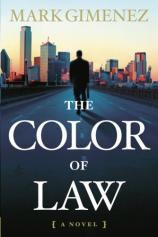The Color of Law
Review
The Color of Law
You sense danger on the dedication page of THE COLOR OF LAW, Mark
Gimenez's debut legal thriller. One of those honored is Harper Lee,
the recluse author of TO KILL A MOCKINGBIRD, whose great novel,
Gimenez notes, "inspired me to become a lawyer and to write this
story." Your sense of foreboding increases with countless
references to the Harper Lee novel in the early pages of THE COLOR
OF LAW. But the final straw occurs when Scott Fenney, the lawyer
protagonist of this novel, introduces the reader to his
nine-year-old daughter, a Jean Louise Finch clone whose nickname is
not Scout, but Boo. There is nothing subtle about this homage to
the great Harper Lee novel. Rookie novelists, however, need to
establish themselves as writers before they seek comparison with TO
KILL A MOCKINGBIRD, a book recently honored as one of the 100
greatest works of fiction of the twentieth century.
THE COLOR OF LAW has all the necessary ingredients for an exciting
courtroom thriller. The crime is a sensational murder of the son of
the most powerful politician in Texas. The defendant is a beautiful
drug addict and prostitute whose only hope for acquittal rests in
unearthing evidence that will besmirch the reputation of that
powerful family. Her lawyer is a high-power partner in a prominent
Dallas law firm whose speech to a group of attorneys calling upon
them to act in the highest tradition of the law, to be lawyers like
Atticus Finch, draws the attention of the federal judge presiding
over the murder case. He appoints Scott Fenney to represent
Shawanda Jones, and all the elements appear to be in place for a
rip-roaring Texas-style murder trial. Alas, ingredients alone do
not make a world-class soufflé. Someone must mix those
ingredients into a finished product. Mark Gimenez has not yet
mastered the skill to turn his ingredients into a first-class
novel.
Two substantial problems hinder THE COLOR OF LAW from earning kudos
as a courtroom thriller. For a 400-page novel to be considered a
work of courtroom fiction, it needs to spend more time in the
courtroom than the final 85 pages. Gimenez spends far too much time
in his novel describing the trappings of high-power, high-living
lawyers and devotes too little time to the actual courtroom
proceedings that will establish guilt or innocence. While the
lifestyle of Scott Fenney becomes an important issue in his
preparation of a vigorous defense for his client, the trappings of
wealth are too lovingly portrayed in the novel. The result is a
plot that is both unwieldy and hard to believe.
Gimenez's second difficulty finds its source in the fact that he
seems to be enamored with young children who have wisdom far beyond
their years. While this formula may have succeeded in TO KILL A
MOCKINGBIRD, Gimenez simply cannot make his two young characters,
Fenney's daughter Boo and Shawanda's daughter Pajamae credible. In
his zeal to recreate Harper Lee's effort, Gimenez seems to have
forgotten that Scout Finch was the narrator looking back on her
life experience. Pre-teenage characters behaving as Gimenez's
protagonists are simply too difficult for readers to accept.
THE COLOR OF LAW has some worthy attributes. Although arriving late
to the courtroom, the scenes detailed there by Gimenez have a
realistic and entertaining flavor. As an author he obviously knows
Texas law and lawyers and has some interesting opinions of both.
But he needs to be either a courtroom novelist or a social
commentator in order to succeed in a field where writers such as
Grisham, Lescroart and Turow have earned deserved praise. In his
next novel one hopes that Gimenez finds a better recipe for
success.
Reviewed by Stuart Shiffman on December 28, 2010





